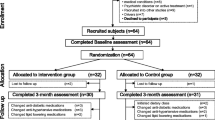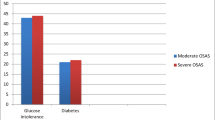Abstract
Background
Obstructive sleep apnea has been linked with metabolic syndrome characterized by dyslipidemia, dyscoagulation, hypertension, and diabetes mellitus type 2 and their cardiovascular consequences. This study was designed to determine the effects of 8 weeks of therapy with continuous positive airway pressure (CPAP) on insulin resistance, glucose, and lipid profile, and the relationship between leptin and insulin-resistance parameters in patients with moderate-to-severe obstructive sleep apnea.
Methods
In 44 patients, serum cholesterol, triglycerides, high-density lipoprotein, low-density lipoprotein, very low-density lipoprotein, leptin, and insulin parameters were measured at baseline and after 8 weeks of CPAP. Insulin resistance index was based on the homeostasis model assessment (HOMA-IR) method. Insulin sensitivity (HOMA-S) and insulin secretion capacity (HOMA-β) also were calculated. Thirteen patients were excluded from statistical analyses due to noncompliant CPAP usage (<4 h night−1).
Results
In 31 patients who used CPAP for ≥4 h night−1, CPAP therapy reduced total cholesterol (P < 0.05), low-density lipoprotein (P < 0.05), and leptin (P < 0.05). Circulating leptin levels showed significant correlation with both HOMA-S and HOMA-IR at baseline and follow-up (P = 0.03 for all). In addition, there was no correlation between HOMA-IR and the severity of sleep apnea, which was shown by apnea-hypopnea index.
Conclusions
In patients with moderate-to-severe obstructive sleep apnea, compliant CPAP usage may improve insulin secretion capacity, reduce leptin, total cholesterol, and low-density lipoprotein levels. Leptin showed significant relationship with insulin resistance, and this relationship remained after 8 weeks of CPAP therapy.


Similar content being viewed by others
References
Young T, Palta M, Dempsey J, Skatrud J, Weber S, Badr S (1993) The occurrence of sleep-disordered breathing among middle-aged adults. N Engl J Med 328:1230–1235. doi:10.1056/NEJM199304293281704
Olson LG, King MT, Hensley MJ, Saunders NA (1995) A community study of snoring and sleep-disordered breathing: prevalence. Am J Respir Crit Care Med 152:711–716
Vgontzas AN, Bixler EO, Chrousos GP (2003) Metabolic disturbances in obesity versus sleep apnoea: the importance of visceral obesity and insulin resistance. J Intern Med 254:32–44. doi:10.1046/j.1365-2796.2003.01177.x
Vgontzas AN, Bixler EO, Chrousos GP (2005) Sleep apnea is a manifestation of the metabolic syndrome. Sleep Med Rev 9:211–224. doi:10.1016/j.smrv.2005.01.006
Ünal M, Öztürk L (2005) The effect of body mass index on the severity of obstructive sleep apnea. In: Ferrera LA (ed) Body mass index and health. Nova Science Publishers, New York, pp 81–96
Dancey DR, Hanly PJ, Soong C, Lee B, Shepard J, Hoffstein V (2003) Gender differences in sleep apnea: the role of neck circumference. Chest 123:1544–1550. doi:10.1378/chest.123.5.1544
Vgontzas AN, Papanicolaou DA, Bixler EO, Hopper K, Lotsikas A, Lin HM, Kales A, Chrousos GP (2000) Sleep apnea and daytime sleepiness and fatigue: relation to visceral obesity, insulin resistance, and hypercytokinemia. J Clin Endocrinol Metab 85:1151–1158. doi:10.1210/jc.85.3.1151
American Diabetes Association (1998) Consensus development conference on insulin resistance. Diabetes Care 21:1–5
Reaven GM (1988) Role of insulin resistance in human disease. Banting Lecture 1988. Diabetes 37:1595–1607. doi:10.2337/diabetes.37.12.1595
Despres JP, Lamarche B, Mauriege P, Cantin B, Dagenais GR, Moorjani S, Lupien PJ (1996) Hyperinsulinemia as an independent risk factor for ischemic heart disease. N Engl J Med 334:952–957. doi:10.1056/NEJM199604113341504
Zhang Y, Proenca R, Maffei M, Barone M, Leopold L, Friedman JM (1994) Positional cloning of the mouse obese gene and its human homologue. Nature 372:425–432. doi:10.1038/372425a0
Frühbeck G, Jebb SA, Prentice AM (1998) Leptin: physiology and pathophysiology. Clin Physiol 18:399–419. doi:10.1046/j.1365-2281.1998.00129.x
Öztürk L, Ünal M, Tamer L, Çelikoğlu F (2003) The association of the severity of obstructive sleep apnea with plasma leptin levels. Arch Otolaryngol Head Neck Surg 129:538–540. doi:10.1001/archotol.129.5.538
Kapsimalis F, Varouchakis G, Manousaki A et al (2008) Association of sleep apnea severity and obesity with insulin resistance, C-reactive protein, and leptin levels in male patients with obstructive sleep apnea. Lung 186:209–217. doi:10.1007/s00408-008-9082-x
Chin K, Shimizu K, Nakamura T, Narai N, Masuzaki H, Ogawa Y, Mishima M, Nakamura T, Nakao K, Ohi M (1999) Changes in intra-abdominal visceral fat and serum leptin levels in patients with obstructive sleep apnea syndrome following nasal continuous positive airway pressure therapy. Circulation 100:706–712
Saarelainen S, Lahtela J, Kallonen E (1997) Effect of nasal CPAP treatment on insulin sensitivity and plasma leptin. J Sleep Res 6:146–147
Aizawa-Abe M, Ogawa Y, Masuzaki H, Ebihara K, Satoh N, Iwai H, Matsuoka N, Hayashi T, Hosoda K, Inoue G, Yoshimasa Y, Nakao K (2000) Pathophysiological role of leptin in obesity-related hypertension. J Clin Invest 105:1243–1252. doi:10.1172/JCI8341
Konstantinides S, Schafer K, Koschnick S, Loskutoff DJ (2001) Leptin-dependent platelet aggregation and arterial thrombosis suggests a mechanism for atherothrombotic disease in obesity. J Clin Invest 108:1533–1540
Murakami T, Iida M, Shima K (1995) Dexamethasone regulates obese expression in isolated rat adipocytes. Biochem Biophys Res Commun 214:1260–1267. doi:10.1006/bbrc.1995.2422
Wabitsch M, Jensen PB, Blum WF et al (1996) Insulin and cortisol promote leptin production in cultured human fat cells. Diabetes 45:1435–1438. doi:10.2337/diabetes.45.10.1435
Rechtschaffen A, Kales AA (1968) A manual of standardized terminology, techniques and scoring for sleep stages of human subjects. National Institutes of Health publication No.204. Government Printing Office, Washington, DC
Gokcel A, Baltali M, Tarim E, Bagis T, Gumurdulu Y, Karakose H, Yalcin F, Akbaba M, Guvener N (2003) Detection of insulin resistance in Turkish adults: a hospital-based study. Diabetes Obes Metab 5:126–130. doi:10.1046/j.1463-1326.2003.00253.x
Wallace TM, Matthews DR (2002) The assessment of insulin resistance in man. Diabet Med 19:527–534. doi:10.1046/j.1464-5491.2002.00745.x
Ascaso JF, Romero P, Real JT, Lorente RI, Martinez-Valls J, Carmena R (2003) Abdominal obesity, insulin resistance and metabolic syndrome in a southern European population. Eur J Intern Med 14:101–106. doi:10.1016/S0953-6205(03)00022-0
Segal KR, Landt M, Klein S (1996) Relationship between insulin sensitivity and plasma leptin concentrations in lean and obese males. Diabetes 45:988–991. doi:10.2337/diabetes.45.7.988
Dorkova Z, Petrasova D, Molcanyiova A, Popovnakova M, Tkacova R (2008) Effects of CPAP on cardiovascular risk profile in patients with severe obstructive sleep apnea and metabolic syndrome. Chest 134:686–692. doi:10.1378/chest.08-0556
Harsch IA, Schahin SP, Radespiel-Troger M et al (2004) Continuous positive airway pressure treatment rapidly improves insulin sensitivity in patients with obstructive sleep apnea syndrome. Am J Respir Crit Care Med 169:156–162. doi:10.1164/rccm.200302-206OC
Comondore VR, Cheema R, Fox J et al (2008) The impact of CPAP on cardiovascular biomarkers in minimally symptomatic patients with obstructive sleep apnea: a pilot feasibility randomized crossover trial. Lung 186:209–217. doi:10.1007/s00408-008-9082-x
Ostlund RE, Yang JW, Klein S et al (1996) Relation between plasma leptin concentration and body fat, gender, diet, age, and metabolic covariates. J Clin Endocrinol Metab 81:3909–3913. doi:10.1210/jc.81.11.3909
Harsch IA, Konturek PC, Koebnick C, Kuehlein PP, Fuchs FS, Schahin SP, Wiest GH, Hahn EG, Lohmann T, Ficker JH (2003) Leptin and ghrelin levels in patients with obstructive sleep apnoea: effect of CPAP treatment. Eur Respir J 22:251–257. doi:10.1183/09031936.03.00010103
Kieffer TJ, Heller RS, Habener JF et al (1996) Leptin receptors expressed on pancreatic beta-cells. Biochem Biophys Res Commun 224:522–527. doi:10.1006/bbrc.1996.1059
Kolaczynski JW, Nyce MR, Considine TV et al (1996) Acute and chronic effects of insulin on leptin production in humans: studies in vivo and in vitro. Diabetes 45:699–701. doi:10.2337/diabetes.45.5.699
Buechner NJ, Zidek W, Esser M, Haske M, Sanner BM (2001) Obstructive sleep apnea syndrome. Effects of therapy on dyslipidemia. Somnologie 5:97–102. doi:10.1046/j.1439-054X.2001.01159.x
Mazzone T, Foster D, Chait A (1984) In vivo stimulation of low-density lipoprotein degradation by insulin. Diabetes 33:333–338. doi:10.2337/diabetes.33.4.333
Wallace TM, Levy JC, Matthews DR (2004) Use and abuse of HOMA modeling. Diabetes Care 21:568–576
Author information
Authors and Affiliations
Corresponding author
Rights and permissions
About this article
Cite this article
Çuhadaroğlu, Ç., Utkusavaş, A., Öztürk, L. et al. Effects of Nasal CPAP Treatment on Insulin Resistance, Lipid Profile, and Plasma Leptin in Sleep Apnea. Lung 187, 75–81 (2009). https://doi.org/10.1007/s00408-008-9131-5
Received:
Accepted:
Published:
Issue Date:
DOI: https://doi.org/10.1007/s00408-008-9131-5




